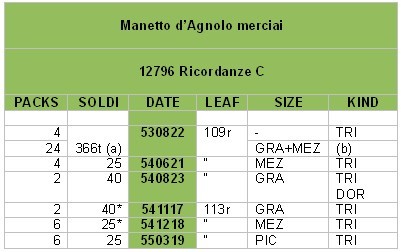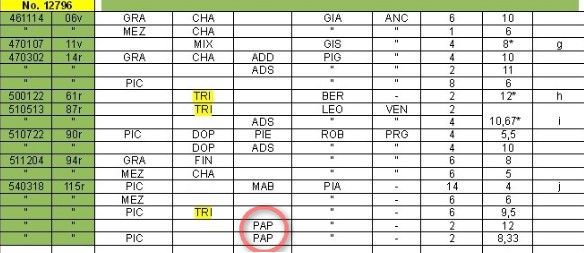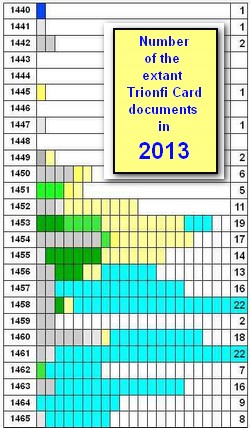"Paparello" - alias Iacopo di Poggino di Luca (1398-1481)
composed by Lothar Teikemeier, last updated 18.12.2012
|
Recorded activities for Puri family: 1447 First recorded activity for Silk dealers: 1453-08-22 Last recorded activity for Silk dealers: 1455-03-19 |
|
Sources
Sources are mainly taken from Franco Pratesi's new article series written from November 2011 till now, published here at Trionfi.com.| SOURCE 1: Puri family sells worthwhile decks |
|
Quote from Franco Pratesi: "1447-1449 - NAIBI ON SALE", 27.01.2012,", 21.01.2012 |
Naibi "fini"There is not only one kind of playing cards indicated under the common denomination of naibi: we find more different packs than we could expect. Let us first conclude our discussion of the "simple" playing cards with a last point worth noting. At the time, one could acquire different kinds of cards, at different prices. When I was a child, a few years later than one could actually visit this merciaio store in person, we had two kinds of local cards, of course Fiorentine grandi, but also Toscane piccole, with exactly the same figures appearing on the cards. I did not imagine that this difference in card dimension could have such a long tradition.  Several columns are the same as in the previous Table. The middle one here adds some indication on the pack in question. Then here we have the number of packs (instead of the dozens as in the previous Table) and their individual prices. In the last columns the makers are indicated, with GI for Giovanni di San Giovanni, PA for Paparello, and CH where chorone (crowns) are mentioned, see below. |
| SOURCE 2: Chorone - Special cards or a game |
Franco Pratesi: 1445 and 1447 - THE RIDDLE OF THE CROWNS by Franco Pratesi, 11.03.2012
Paparello is likely involved in the production of worthwhile cards, which are called "Chorone" (Crowns). This is a very rare expression for playing cards, and the name appeared to the surface in the last year 2012 in the researches of Franco Pratesi. So there is a riddle, what these "crowns" might have been and if there is any relation to our most researched object, the Trionfi cards.
Compare also the article to Manetto d'Agnolo merciai.
| SOURCE 3: Silk dealer aquire decks |
|
Quote from Franco Pratesi: "1431-1460: NAIBI ACQUIRED BY SILK-DEALERS", 20.04.2012 |
Manetto d'Agnolo merciaiSometimes we find cards from other suppliers, different from the "usual" cardmakers. Also a mercer (as typically Manetto d’Agnolo) could sometimes pay part of his debts with playing cards that he had acquired from elsewhere. (a) The total recorded is L.18s.6. which would give 13s.* as average value for the three different packs. I could not find how to convincingly divide it into the three parts mentioned. Assuming 25s. for trionfi the average for grandi and mezzani would be too high at 11,08s*; more likely appear 40s., and 8,58s.*, respectively. |
| SOURCE 4: Silk dealer sell decks |
Detail of the List of Sales of the Silk dealers

Paparello decks are sold together with Trionfi decks at 1454-03-18 (the Trionfi card painter stays anonymous). MAB at the same day stands for Matteo Bellerini and PAP for Paparello.
| SOURCE 5: Werner Jacobsen list |
|
Quote from Franco Pratesi: "CARDMAKERS AND WOODBLOCKS ON TRIAL", 21.01.2012 |
Florentine painters of playing cardsJacobsen deals with the painters active in Florence in early Renaissance and divides them according to their main activity. It appears that many specialised sectors of the handicraft existed, even if one can easily imagine that most painters could be active at the same time in various of these sectors. Understandably, painters of playing cards were not among the most renowned artists of the time, but we can find there specialisations that can be even more unexpected, such as have been for me those of painters of arms or of tall church candles.
I am certain that a few names can be added to this list, to begin with those already found by Zdekauer and/or Kristeller more than a century ago. For instance, Antonio di Luca, present in Catasto 1427; Antonio di Giovanni di Ser Francesco, who declared the possession of woodblocks in Catasto 1430; moreover, Benedetto di Antonio Spigliati, who is introduced by Jacobsen himself (see below) but absent in the list, because his activity is concentrated after the time interval studied. |
My Note: Iacopo di Poggino di Luca «Paparello» (1398-1481) appears also at the Jacobsen list of Florentine Playing Card producers.
| SOURCE 6: Lodovico Zdekauer list |
|
Source: composed according a note of Ross Caldwell in 2010
|
My Note: "Paparello" appears as "Jacopo di Poggino" also at the Zdekauer list of Florentine Playing Card producers.
|
Repeated Note: When Ross Caldwell and me in 2003 started to collect Trionfi notes between 1442-1463, we had about 27/28 entries (which I nowadays would count as 31). The major part were the documents of Ferrara, which were collected by Gherardo Ortalli and Adriano Franceschini in the "Prince and the Playing Cards" (1996), after the base laying works of Michael Dummett and Stuart Kaplan around 1980. This collection included 2 notes about Trionfi cards in Florence, found by Franco Pratesi in his earlier work (allowances of the Trionfi game in 1450 and 1463). A graphical representation of this time (with 27 entries) shows the dominance of Ferrarese documents (in black) with a few notes only from other locations (in red; see picture to the right) In the period 2004 till October 2011 it was possible to add 4 further notes (Siena 1452, Padova 1455, Ancona c. 1460 and Valerio Marcello c. 1460), mainly thanks to information given by Thierry Depaulis. Franco Pratesi started his new article series in November 2011. Since then the list has gotten 67 new documents till September 2012 (65 of them found by Franco Pratesi, one, now the oldest of September 1440, by Thierry Depaulis, and another one by Veber Gulinelli, who controlled the earlier work of Franceschini and found an overlooked document) and nearly all are related to Florence or its surrounding. A small book (118 pages) was published around Christmas 2012, Franco Pratesi: "Playing Card Trade in 15th Century Florence" as IPCS Paper No. 7 (ISSN 0305-2133). It contains some of the articles, which before had appeared at this website, those, which treat the early time of 15th century. Thierry Depaulis commented in his foreword: "This book is a landmark in the history of early playing cards in Italy". Well, maybe not the book, but the research is clearly a landmark in various interests. For the collection of early Trionfi notes it somehow means, that we have within the year 2012 about 200 % more data for the period 1440-1462 than mankind had collected in the 200 years before. Added later: In August 2013 the new report of Arnold und Doris Esch: "Aus der Frühgeschichte der Spielkarte. Der Import von carte da giocare und trionfi nach Rom." in Gutenberg Jahrbuch 2013, 88. Jahrgang, p. 41-53, arrived in our redaction. It contains 106 new references to Trionfi decks, which all were found in the customs registers of the city Rome for the period 1453-1465. With this the number of all earlier Trionfi cards records has been doubled and should have reached then c. 210 (from which a few are only considered to be "Trionfi card notes" and don't contain the word "Trionfi" or something similar). *********** I'd started to sort the new Trionfi card documents overview in October 2012. Articles will be possibly changed according improvements in research. |
|


